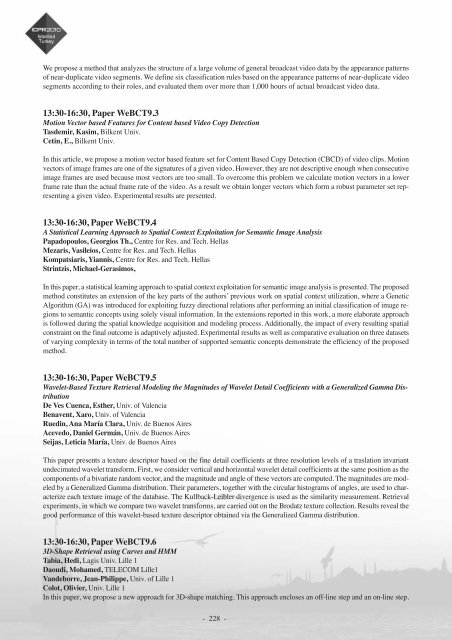Abstract book (pdf) - ICPR 2010
Abstract book (pdf) - ICPR 2010
Abstract book (pdf) - ICPR 2010
- TAGS
- abstract
- icpr
- icpr2010.org
You also want an ePaper? Increase the reach of your titles
YUMPU automatically turns print PDFs into web optimized ePapers that Google loves.
We propose a method that analyzes the structure of a large volume of general broadcast video data by the appearance patterns<br />
of near-duplicate video segments. We define six classification rules based on the appearance patterns of near-duplicate video<br />
segments according to their roles, and evaluated them over more than 1,000 hours of actual broadcast video data.<br />
13:30-16:30, Paper WeBCT9.3<br />
Motion Vector based Features for Content based Video Copy Detection<br />
Tasdemir, Kasim, Bilkent Univ.<br />
Cetin, E., Bilkent Univ.<br />
In this article, we propose a motion vector based feature set for Content Based Copy Detection (CBCD) of video clips. Motion<br />
vectors of image frames are one of the signatures of a given video. However, they are not descriptive enough when consecutive<br />
image frames are used because most vectors are too small. To overcome this problem we calculate motion vectors in a lower<br />
frame rate than the actual frame rate of the video. As a result we obtain longer vectors which form a robust parameter set representing<br />
a given video. Experimental results are presented.<br />
13:30-16:30, Paper WeBCT9.4<br />
A Statistical Learning Approach to Spatial Context Exploitation for Semantic Image Analysis<br />
Papadopoulos, Georgios Th., Centre for Res. and Tech. Hellas<br />
Mezaris, Vasileios, Centre for Res. and Tech. Hellas<br />
Kompatsiaris, Yiannis, Centre for Res. and Tech. Hellas<br />
Strintzis, Michael-Gerasimos,<br />
In this paper, a statistical learning approach to spatial context exploitation for semantic image analysis is presented. The proposed<br />
method constitutes an extension of the key parts of the authors’ previous work on spatial context utilization, where a Genetic<br />
Algorithm (GA) was introduced for exploiting fuzzy directional relations after performing an initial classification of image regions<br />
to semantic concepts using solely visual information. In the extensions reported in this work, a more elaborate approach<br />
is followed during the spatial knowledge acquisition and modeling process. Additionally, the impact of every resulting spatial<br />
constraint on the final outcome is adaptively adjusted. Experimental results as well as comparative evaluation on three datasets<br />
of varying complexity in terms of the total number of supported semantic concepts demonstrate the efficiency of the proposed<br />
method.<br />
13:30-16:30, Paper WeBCT9.5<br />
Wavelet-Based Texture Retrieval Modeling the Magnitudes of Wavelet Detail Coefficients with a Generalized Gamma Distribution<br />
De Ves Cuenca, Esther, Univ. of Valencia<br />
Benavent, Xaro, Univ. of Valencia<br />
Ruedin, Ana María Clara, Univ. de Buenos Aires<br />
Acevedo, Daniel Germán, Univ. de Buenos Aires<br />
Seijas, Leticia María, Univ. de Buenos Aires<br />
This paper presents a texture descriptor based on the fine detail coefficients at three resolution levels of a traslation invariant<br />
undecimated wavelet transform. First, we consider vertical and horizontal wavelet detail coefficients at the same position as the<br />
components of a bivariate random vector, and the magnitude and angle of these vectors are computed. The magnitudes are modeled<br />
by a Generalized Gamma distribution. Their parameters, together with the circular histograms of angles, are used to characterize<br />
each texture image of the database. The Kullback-Leibler divergence is used as the similarity measurement. Retrieval<br />
experiments, in which we compare two wavelet transforms, are carried out on the Brodatz texture collection. Results reveal the<br />
good performance of this wavelet-based texture descriptor obtained via the Generalized Gamma distribution.<br />
13:30-16:30, Paper WeBCT9.6<br />
3D-Shape Retrieval using Curves and HMM<br />
Tabia, Hedi, Lagis Univ. Lille 1<br />
Daoudi, Mohamed, TELECOM Lille1<br />
Vandeborre, Jean-Philippe, Univ. of Lille 1<br />
Colot, Olivier, Univ. Lille 1<br />
In this paper, we propose a new approach for 3D-shape matching. This approach encloses an off-line step and an on-line step.<br />
- 228 -



